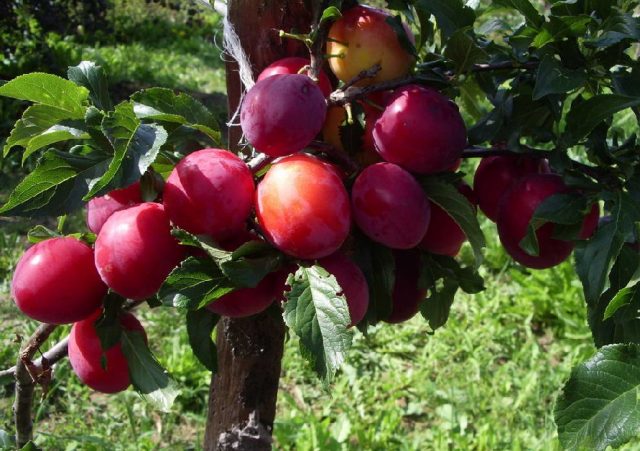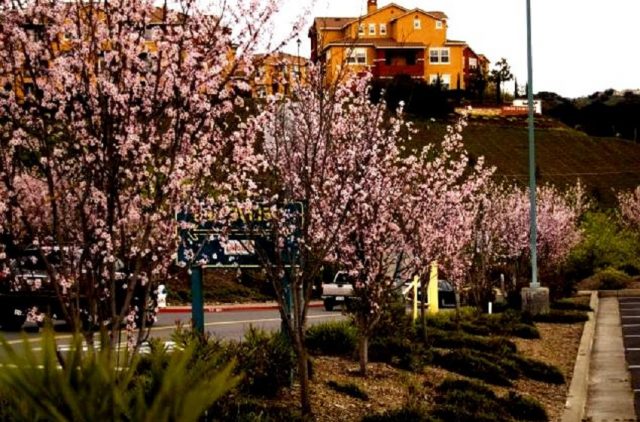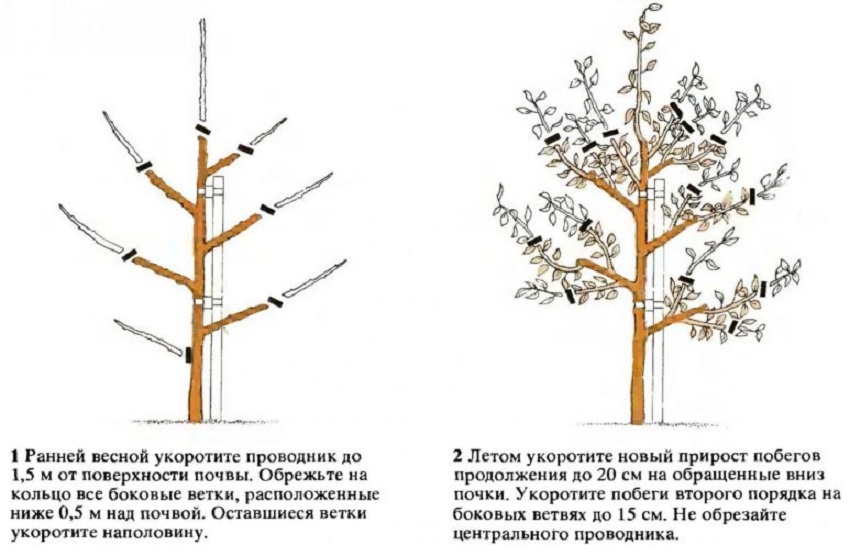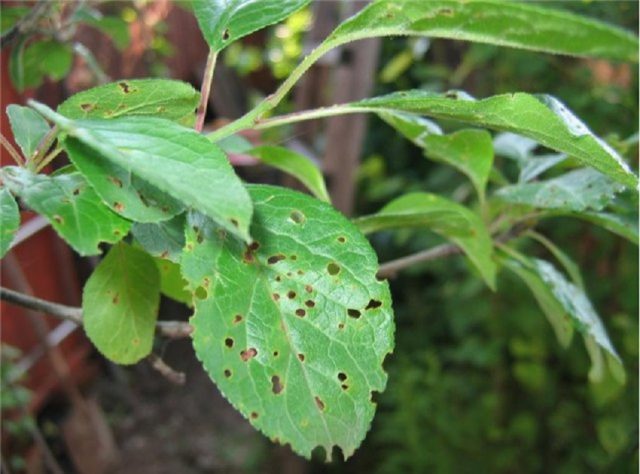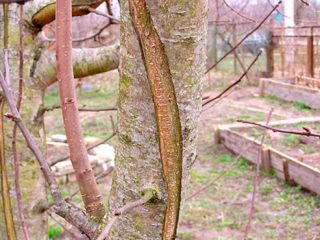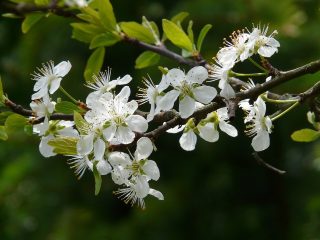Content
Plum Red Ball is a popular and favorite variety of gardeners. They choose a Chinese woman for tasty fruits and short stature. Unlike standard varieties, the Red Ball is easy to care for.
Breeding history of the variety
Breeding work is aimed at creating varieties that best meet the needs of gardeners. The Chinese plum Red Ball combines the characteristics of the American Burbank variety and the Russian Ussuriyskaya red. The authors were Kh. K. Enikeev and S. N. Satarova. The work on crossing the species was carried out in the laboratory of the Moscow All-Russian Institute of Selection and Technology of Horticulture and Nursery. The variety was included in the State Register in 1989. This variety of plum has a second name Raspberry ball.
Plum Red Ball Description
The tree is very convenient for growing in the garden. Plum Ball Red attracts with the parameters of not only the fruit, but also the tree. An adult plant reaches a height of no more than 2.5 m, which makes care, as well as harvesting, very comfortable.
The bark is smooth brown. There are very few branches on the tree, they are spreading. Therefore, the crown cannot be called thickened. The variety forms ovaries on annual shoots and bouquet twigs, which must be taken into account when pruning. The leaves are large, green, with a dull color, serrated edge. The plum blossoms until the leaves appear. It expels 2-3 flowers from one bud, so the tree looks like a huge flower. But not every flower gives an ovary. The fruits are the pride of the plum. Large balls, justifying the name of the variety, reach a weight of 40 g each.
The pulp is loose, slightly fibrous, the skin is dense with an inconspicuous side seam. The juice is very aromatic, sweet taste, tasty and healthy. The bone is easily detached.
According to the recommendations of the originators of the variety, it is best to grow the Red Shar plum in the regions of the Central Region.
Variety characteristics
To get the desired result, familiarity with the characteristics of the plum is necessary. In this case, the whole cultivar care algorithm becomes clear.
Drought resistance, frost resistance
The frost resistance of the Red Ball is very high. Even prolonged frosts down to -35aboutC and temperature fluctuations do not affect the condition of the tree, its yield. This characteristic of the Red Ball plum variety allows fruit to be grown in areas with cold winters. But sudden return frosts are not very desirable, the tree may freeze slightly.
Plum pollinators Red Ball
For good fruiting of plums, planting of other varieties is necessary. The Raspberry Ball is a self-fertile species. The best pollinating varieties for the Red Ball plum are plants that bloom in the same period:
- plum Chinese;
- plum sissy;
- plum Early;
- cherry plum Kuban comet;
- cherry plum Gold of the Scythians.
Blossoming at the Red Ball comes very early, 2 weeks earlier than other varieties. The number of ovaries should be normalized, and flowers should be removed in the first two years after planting.Otherwise, the fruits will be small, the ripening of the crop will be delayed.
Productivity and fruiting
Plum begins to bear fruit quickly, in 2-3 years after planting the first crop can be harvested. The fruits ripen in August. The peculiarity of flowering (the number of flowers from one bud) makes it possible to collect up to 18 kg of large "plum balls" from one tree.
Scope of berries
Plum Raspberry Ball belongs to table varieties. Therefore, the fruits are equally good both fresh and prepared. Plum jam, preserves, jam, compotes, juices are prepared from them. A very popular variety for making table wine.
Disease and pest resistance
The Chinese plum variety Krasny Shar has a high resistance to perforated spot (clasterosporium disease), monilial burn and other fungal infections.
Advantages and disadvantages of the variety
A description of the Raspberry Ball plum and reviews of practicing gardeners allow us to highlight the advantages and disadvantages of the variety. The pluses include:
- versatility of application, taste and commercial qualities of fruits;
- high productivity;
- early ripening;
- good portability;
- early maturity;
- frost resistance;
- convenient size of the tree, medium thickening of the crown.
Gardeners consider the disadvantages of the variety:
- early flowering period, which may coincide with the period of return frosts;
- self-fertility, the need for additional pollination;
- preheating of the root collar in the spring.
Landing features
The planting of the Raspberry Ball variety does not differ from the rest of the plums. But the further development and growth of the seedling depends on the quality and timeliness of the event.
Recommended timing
In areas of the middle lane, the Red Ball plum is planted in spring, best of all in April. For the southern regions, autumn planting is recommended: in late September or early October. If the seedling is purchased at a later date, then it is added dropwise in an inclined position until spring.
Choosing the right place
For the Krasny Shar variety, the optimal place will be a plot on the southeastern or western side of the garden with fertile soil. Plum does not tolerate stagnant water, so they plant a tree on a hill or make good drainage. The second nuance is draft protection. This role can be played by a wall of a building or shrubs.
Important! Plums should not be planted in close proximity to nightshades.
What crops can and cannot be planted nearby
Plum responds favorably to the proximity of apple, black elderberry and currant. But next to a nut, pear, hazel, fir, birch, poplar, you should not plant a Raspberry Ball. For small garden plots, it is possible to combine a plum with a pear only if the distance between the trees is at least 4 m.
Selection and preparation of planting material
For planting plums, it is better to take a one-year-old Red Ball seedling. According to the observations of gardeners, they take root well. Focus on:
- Roots. Must be moist, free from damage, kinks, signs of decay.
- Kore... It is important that there are no cracks, wrinkles, and the stem is in good condition.
Landing algorithm
3 weeks before planting the Raspberry Ball plum, dig a hole 65 cm x 70 cm.
Mix fertile soil (2 buckets) with humus or compost (1 bucket), 400 g of superphosphate, 1 kg of wood ash. Soak the roots of the plum sapling in water for 6 hours.
Form a mound of soil at the bottom of the pit, install a plum sapling, level the roots.
Sprinkle with soil.
Make a periosteal circle, pour over the plum, mulch.
Plum follow-up care
The main activities for the care of the Red Shar variety consist of:
- Glaze. Plum is sensitive to soil moisture. Overflow leads to decay of the roots, moisture deficiency leads to drying out. An adult tree needs 25-30 liters per week, especially at the beginning of summer, when the harvest is ripening and the formation of fruit buds.
- Top dressing. The variety is not picky about annual feeding. For plums, it is enough to add organic matter and mineral complex fertilizers once every 3-4 years. The organic matter is dug up with the soil, and minerals are added in the form of a solution after watering. It is necessary to feed the early ripening Chinese plum Red Ball in the fall, and in the spring to add nitrogen components.
- Pruning. For the variety, only preventive and sanitary pruning is recommended. The crown of the plum is not thickened, so attention should be paid to cutting out the growth, shortening the shoots, removing broken and dry branches.
- Winter preparations. It is necessary to prepare the plum for the winter period. Despite its frost resistance, the Raspberry Ball variety can suffer from a sharp cold snap after thaws. The second reason is protection from rodents. Cover the trunk well with mulch, followed by tying with burlap.
Diseases and pests, methods of control and prevention
Chinese plum can be amazed:
Disease or pest | Prevention and control measures |
Coccomycosis | Remove plant residues after harvesting and treat with a solution of copper oxychloride (40 g per 10 l of water). |
Fruit rot | Regular removal of damaged fruits. Processing with Bordeaux liquid (1%) during the period of fruit size 3 cm. |
Root cancer | Disinfection of tools and planting material. Plum processing with copper sulfate. |
Milky shine | Autumn whitewashing of the trunk with lime, top dressing with urea before flowering. |
Conclusion
Plum Red Ball is a very beautiful and comfortable tree. At the time of flowering, it is very decorative, when harvesting, it does not cause trouble due to its low growth, the fruits of universal use - it is pleasant for gardeners to grow such varieties.
